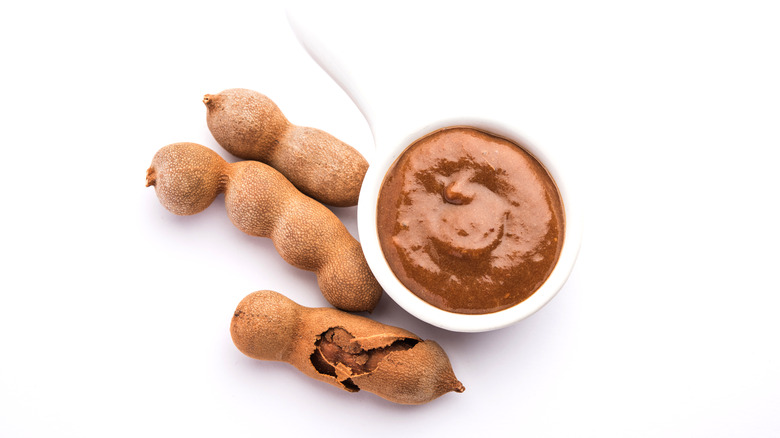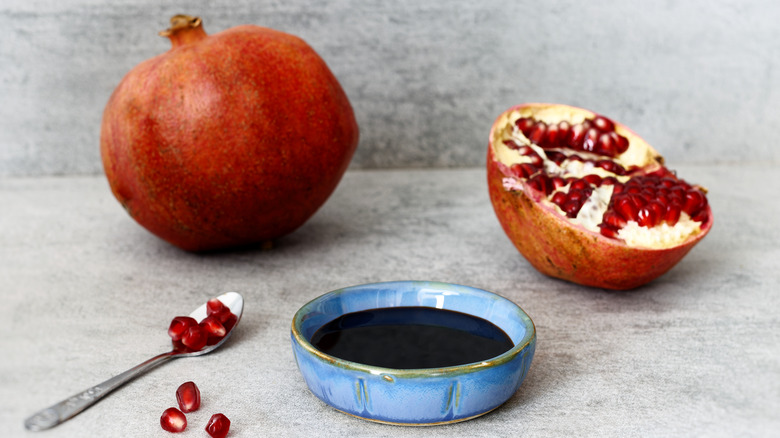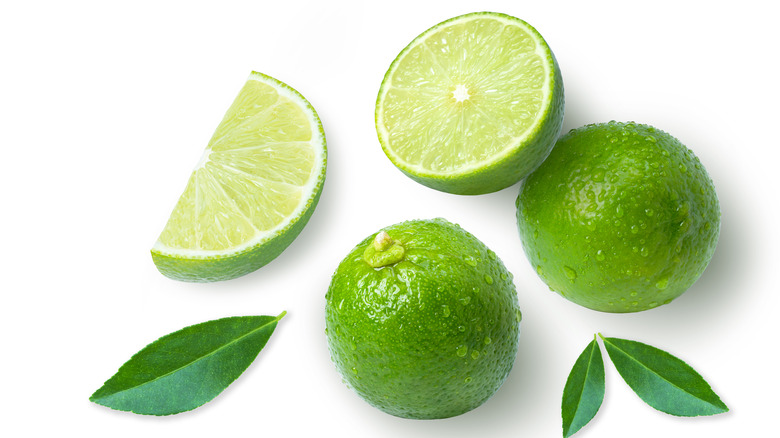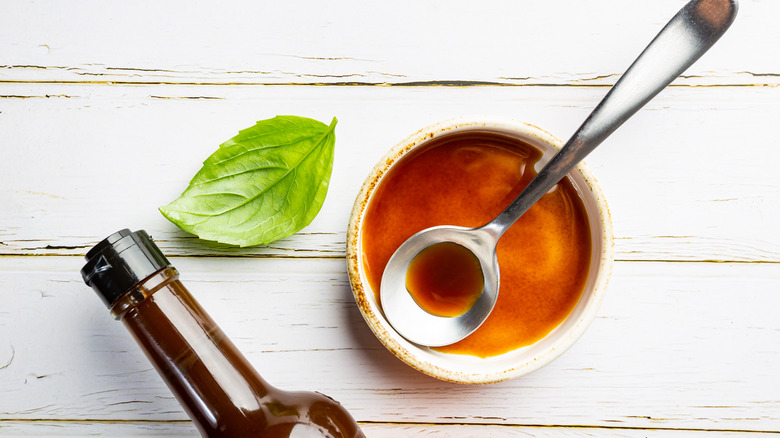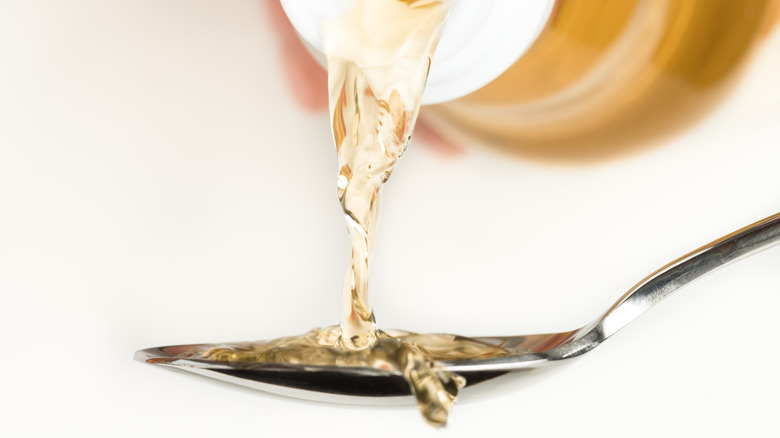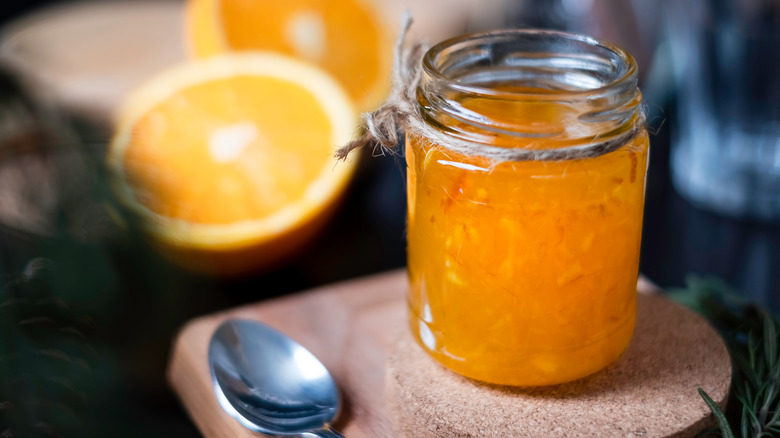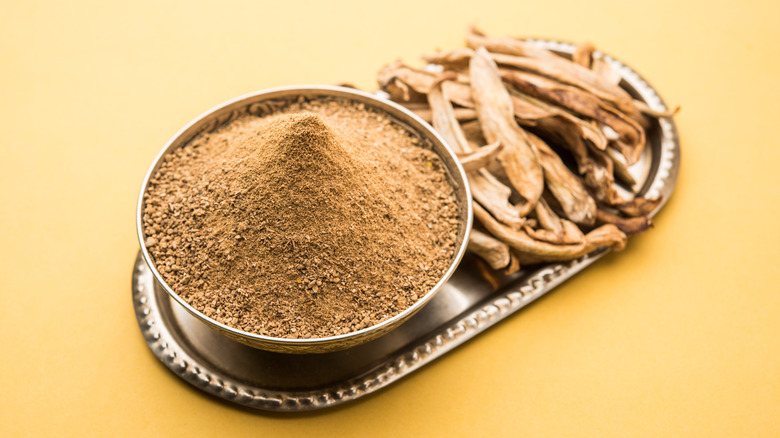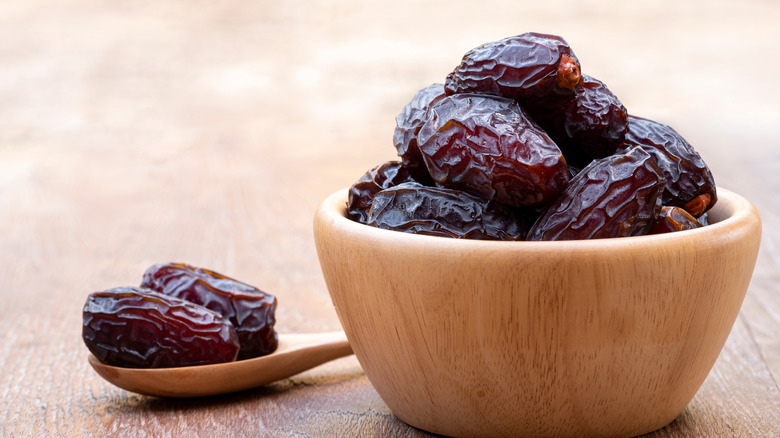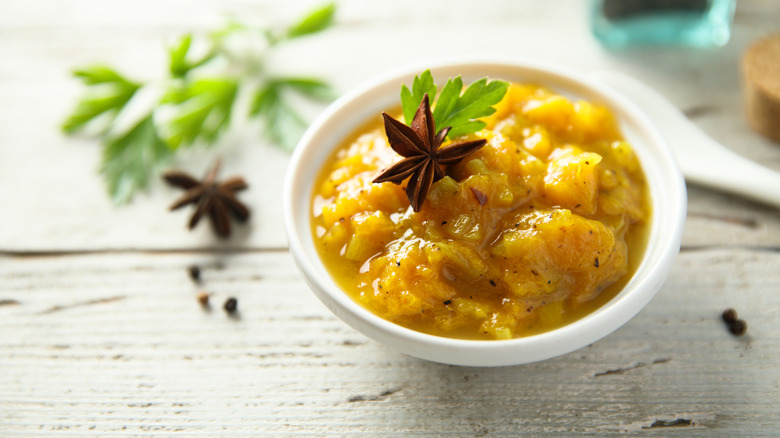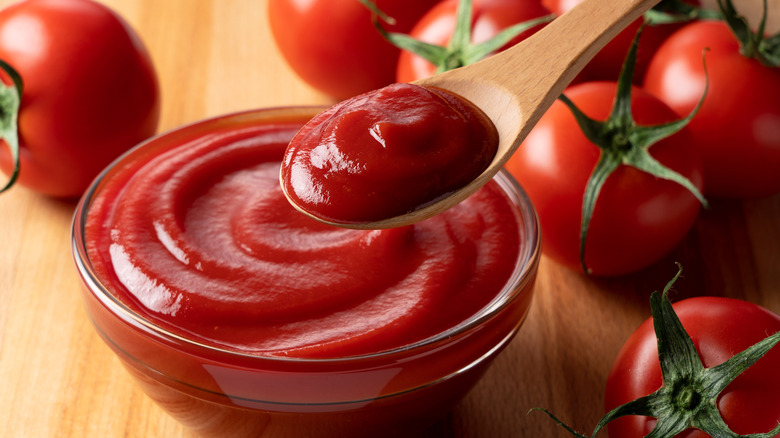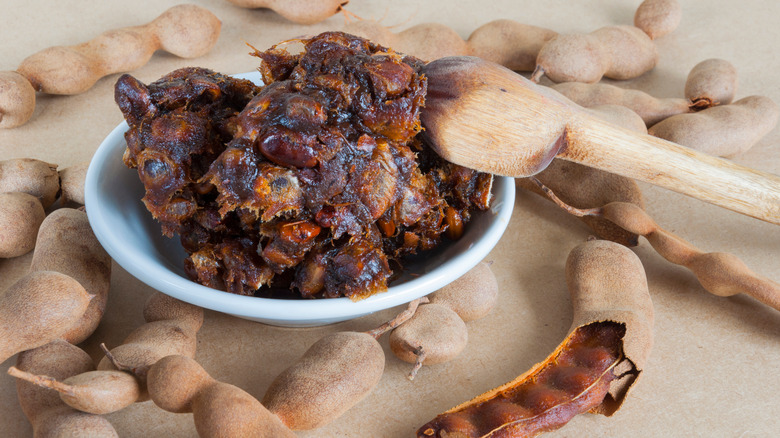10 Best Substitutes For Tamarind Paste
If you're a fan of experimenting in the kitchen with different cuisines, trying your hand at whipping up authentic Thai or Indian curries, or even flavorful Caribbean dishes, you may have come across a recipe that calls for tamarind paste among the ingredients. For those who may not be familiar, tamarind is a fruit that grows in little pods, and the fruit within can be condensed into a flavorful paste available in a jar. Tamarind has a complex mixture of flavor notes, from a dominant sour note to more subtle notes of citrus and even caramel. As many pastes do, it has a thick consistency.
Tamarind paste has a very concentrated flavor, so typically recipes call for quite a small amount of this ingredient — we're talking about a spoonful or two, not half a jar at a time. Thus, a jar of tamarind paste can last you quite a while, and can be stored in the refrigerator for months. In addition to all the flavors it adds to whatever dish you're incorporating it in, tamarind paste is also a nutritional powerhouse that is packed with vitamin C, B vitamins, potassium, iron and phosphorus.
If you're looking to try out a recipe that calls for tamarind paste, but don't want to invest in a whole jar or simply don't want to make an extra trip to the store, don't worry — there are quite a few substitutions that you can consider.
Pomegranate molasses
If you don't happen to have tamarind paste, one of the best substitutes for the unique combination of sour and sweet found in the ingredient is pomegranate molasses (via Recipe Marker). This substitute is a thick syrup that mimics a lot of the same flavors found in tamarind paste. For those who may not be familiar, this doesn't have the same flavor as the molasses you might use in crafting gingerbread — it's simply a reduction of pomegranate juice (via SPICEography). The reduction process and the taste of pomegranate means the end product has a complexity of flavor that makes it an ideal substitute in a variety of dishes.
As an added bonus, the dark color of pomegranate molasses helps to duplicate tamarind paste visually as well as in terms of flavor. It'll bring moisture to your dish as well. The one downside is that this ingredient isn't as common as some of the other potential swaps for tamarind paste, meaning you may not have it in your pantry unless you commonly cook the types of cuisine in which pomegranate molasses is used. For best results, you can do a direct swap — so, if your recipe calls for two tablespoons of tamarind paste, you'd add in two tablespoons of pomegranate molasses instead.
Lime juice and brown sugar
Many of the substitutes for tamarind paste can be tough to find in an average supermarket, and are better sought in specialty grocery stores. Not lime juice and brown sugar, though. This substitution is crafted by combining two very common ingredients that many home cooks will have in their pantry (via SPICEography). The lime juice helps to mimic that tartness and sour notes found in tamarind paste, and in many recipes, the lime juice alone might be enough of a substitute. However, the extra step of adding a bit of brown sugar adds that hint of sweetness that tamarind paste can give a recipe, and also helps to darken the hue. This substitute can be used for many different recipes, including curries.
One thing to note is that, if you're using this substitute in a cold mixture like a salad dressing, you'll want to ensure the brown sugar is completely dissolved so you don't get an undesirable grainy texture in your mixture. To craft this substitution, you'll want to use equal parts of lime juice and brown sugar. Then, for best results, do a straight substitution — so, if a recipe calls for a tablespoon of tamarind paste, you'd use a tablespoon of your sour and sweet lime and sugar mixture.
Worcestershire sauce
If you have this notoriously tough to pronounce ingredient in your fridge, good news — you have a decent substitute for tamarind paste. While Worcestershire sauce may not seem like an ingredient with a ton of exotic flavor, in some brands of the sauce, tamarind extract is actually one of components of this ingredient, giving it that slight tanginess.
The one thing you'll want to be mindful of is the consistency — while tamarind paste is, well, a paste, Worcestershire sauce is a thinner mixture. However, often tamarind paste isn't used in huge quantities, so if you're just swapping in a tablespoon or so, it shouldn't make much of a difference in the consistency of your final recipe. And, in terms of accessibility, this ingredient is a win — you'll find bottles of Worcestershire sauce in the condiment section of most grocery stores, so even if you need to make an extra stop to pick up this substitute, it shouldn't be tough to find. For best results, you'll want to treat this as a direct swap — so, for every tablespoon of tamarind paste your dish calls for, you'd add a tablespoon of Worcestershire sauce instead.
Rice vinegar and brown sugar
This substitute is similar to the concoction of lime juice and brown sugar. However rice vinegar is a pantry ingredient rather than a fresh ingredient — while you may have run out of fresh fruits like limes, it takes a whole lot longer to go through a bottle of vinegar. If you're a fan of cooking Asian cuisine at home, there's a good chance you have a bottle of rice vinegar in your pantry, and while any vinegar can work in a pinch to mimic the sour notes of tamarind paste, rice vinegar has a more delicate flavor that makes it better suited than other types of vinegar.
To make a substitute, you'll simply combine equal parts of rice vinegar and brown sugar (via Cuisine Vault). This combination brings together all those complex flavor notes found in tamarind paste, the sweet and sour, and makes a great substitution. Combining the two will thicken the rice vinegar and make the consistency closer to tamarind paste's consistency. Just make sure that all the sugar crystals from the brown sugar are fully dissolved if you're using it in a cold dish — if it's going into a curry or soup, the heat will help you out. For best results, you'll want to use the same amount of the rice vinegar and brown sugar mixture that you would have used tamarind paste.
Marmalade
If you placed marmalade and tamarind paste side by side in a taste-off, the two wouldn't be too similar. However, when incorporated in a recipe, they actually do have some of the same flavor notes, making marmalade a decent substitute — and an easily accessible one for anyone who loves a morning slice of toast slathered in marmalade (via Cuisine Vault). Marmalade contains some of those sweet flavor notes as well as a slight bitterness, and it can really enhance the flavor of many dishes. It even has a bit of astringency that is comparable to the sourness found in tamarind paste.
As an added bonus, both marmalade and tamarind paste have similar consistencies, which is ideal if you're using this ingredient in a sauce or dressing of some sort where a thinner substitute might compromise the final product. This is another substitution where you'll want a direct swap — so, if your tangy salad dressing calls for a teaspoon of tamarind paste, you'd swap in a teaspoon of marmalade instead.
Amchur powder
This is another one of those substitutions that the average home cook may not have, but if you happen to be a fan of Indian cuisine or have quite a robust spice collection, you just might have it in your pantry. Amchur is a powder that is crafted from dried, unripe mangos, and has similar flavor notes to tamarind paste (via SPICEography). In fact, depending on which part of India a particular dish comes from, amchur powder is often used in the same way tamarind paste is, to add a bit of sourness that lends complexity to a dish.
The one major difference is in the consistency. Amchur powder is, as you might expect, powdered, which is quite different from the thick consistency of tamarind paste. However, if you simply add some water to the amchur powder, you can form more of a paste-like consistency without changing the flavor of your dish. For best results, you can use amchur powder as a direct substitute — for every teaspoon of tamarind paste a recipe calls for, swap in a teaspoon of amchur powder.
Dried fruits and lemon juice
While some home cooks like to find substitutes that are a close enough approximation of the original ingredient without adding any extra work, others are okay with spending a bit of extra time to combine a few components to create a closer match. If you fall into the latter camp, this just might be the substitute for you. If you're a big fan of dried fruits, there's a good chance you'll have these in your pantry for snacking. All you need to do is combine small amounts of dates, prunes, and apricots in a small bowl with water, allowing the dried fruits to soften for about half an hour, before blending them with a teaspoon or so of lemon juice.
The blended mixture will have a thick consistency and almost sticky texture, thanks to the dried fruits, that is a startlingly good dupe for tamarind paste (via The Gardening Cook). Plus, the flavor is a good match as well — you're getting the sweet from your dried fruit, your sour from the lemon juice, and the mixture of different fruits help add complexity of flavor. To make about a tablespoon and a half of the final mixture, you'll need about a teaspoon of each ingredient — although you can also increase the quantities if you think you'll be using it in more recipes. For best results, use the same amount of the fruit and lemon juice paste as you would tamarind paste.
Mango chutney
Mango chutney contains some sweetness and depth of flavor that makes it a good substitute for tamarind paste in certain dishes (via Happy Happy Vegan). However, you'll need to read the label of whatever chutney you have in your pantry or are considering purchasing as a substitute — not all mango chutneys are created equal. Some of the less expensive brands will contain more sugar, which will add too much sweetness without any of those sour notes found in tamarind. You'll also want to make sure there are no strange ingredients in the chutney that could change the overall flavor of your dish (some contain spice or other flavoring agents).
The one downside to this substitute is the consistency — most chutneys have large pieces of fruit in them and are a bit of a chunky texture. It may not make a difference in a dish like a soup, but if you're swapping the mango chutney in something where a smooth consistency is needed, you may wish to toss the chutney in a blender or food processor to adjust the consistency. For best results, do a direct swap — so, for every tablespoon of tamarind paste your recipe calls for, add a tablespoon of mango chutney instead.
Spiced-up ketchup
If you've ever followed a recipe for pad thai and found yourself wondering why on earth ketchup was listed as one of the ingredients, it's because many North American recipes include it as an easy, convenient substitute for tamarind paste. Many households have a bottle of ketchup kicking around, and it's an incredibly accessible ingredient that can be found in just about every grocery store.
While some recipes simply suggest adding the ketchup, others recommend spicing it up a little bit with a few additions to get the flavor notes closer to what tamarind paste delivers in a dish. If you have a relatively well stocked spice and condiment selection, you can mix a tablespoon of ketchup with two tablespoons of brown sugar, two tablespoons of fish sauce, two teaspoons of oyster sauce, two tablespoons of rice vinegar and one teaspoon of soy sauce (via Recipe Tin Eats). Yes, it's a lot of ingredients, but tamarind paste has a complex balance of flavors that is challenging to replicate. You can use this concoction as a direct swap, adding a tablespoon of your sweet, sour, salty and savory mixture in place of every tablespoon of tamarind paste required in your recipe.
Tamarind pulp
There's a good chance that if they don't carry tamarind paste in your regular grocery store, they may not carry tamarind pods. However, if you do have them on hand, or if your supermarket carries them but has run out of paste, you can quite easily make a DIY version of tamarind paste (via New York Times). You simply need to open the tamarind pods, simmer them with a bit of water, and then mash all the fruit to form a paste, draining off any liquid that remains. You'll end up with a thick, sticky paste that is very similar in consistency to tamarind paste, and given that it's crafted from the same ingredient, the flavor will be virtually identical.
This substitution requires a bit more effort, but it could be ideal for someone who wants to ensure they replicate the balance of flavors in the dish they're making perfectly. Give the similarities, this substitute can be used in equal proportions — if your recipe calls for one teaspoon of tamarind paste, you can swap in one teaspoon of your homemade pulp turned into paste.
